
Here are the stats that show why banner ads deliver the lowest ROI in the digital marketing mix.
- Over 5.3 trillion display ads were served to U.S. users last year. (ComScore)
- That’s 1 trillion more than 2009. (ComScore)
- The typical Internet user is served 1,707 banner ads per month. (Comscore)
- Click-through rates are .1 percent. (DoubleClick)
- The 468 x 60 banner has a .04 percent click rate. (DoubleClick)
- An estimated 31 percent of ad impressions can’t be viewed by users. (Comscore)
- The display advertising Lumascape has 318 logos. (Luma Partners)
- 8 percent of Internet users account for 85 percent of clicks. (ComScore)
- Up to 50 percent of clicks on mobile banner ads are accidental. (GoldSpot Media)
- Mobile CPMs are 75 cents. (Kleiner Perkins)
- You’re 471 times more likely to survive a plane crash than click a banner ad. (Solve Media)
- 15 percent of people trust banner ads completely or somewhat, compared to 29 percent for TV ads. (eMarketer)
- 34 percent don’t trust banner ads at all or much, compared to 26 percent for magazine ads. (eMarketer)
- 25-34-year olds see 2,094 banner ads per month. (ComScore)
- 445 different advertisers delivered more than a billion banner ads in 2012. (ComScore)
Put simply, banner ads don't work
Remember these figures next time a media sales rep tries to sell you a banner ad campaign. Even if it’s free it may not be worth the effort, you’re 31 times more likely to win Lotto.
Read More
The A to Z of digital acronyms


Every industry has its acronyms. With this list you will be prepared when dealing with people who speak digital:
AIDA - Attention, Interest, Desire, Action
AJAX - Asynchronous Javascript and XML
API - Application program interface
AOV - Average order value
AR - Augmented reality
ASP - Application service provider
ATD - Agency trading desk
B2B - Business to business
B2C - Business to consumer
CIO- Chief information officer
CLV - Customer lifetime value
CMS - Content management system
CPA - Cost per acquisition / action
CPC - Cost per click
CPL - Cost per lead
CPM - Cost per thousand
CPV - Cost per view (see also PPV)
CR - Conversion rate
CRM - Customer relationship management
CRO - Conversion rate optimisation
CSS - Cascading style sheets
CTA - Call to action
CTR - Click-through rate
CX - Customer experience
DM - Direct mail (or 'Direct message', in Twitter circles)
DMP - Data management platform
DNS - Domain name system
DR - Direct response
DSP - Demand-side platform
ECPM - Effective CPM
EPC - Earnings per click
EPM - Earnings per thousand
ESP - Email service provider
FAQs - Frequently asked questions
FB - Facebook
FBML - Facebook Markup Language
FTP - File transfer protocol
GA - Google Analytics
HIPPO - Highest paid person's opinion
HTML – Hyper Text Markup Language
HTTP - Hyper Text Transfer Protocol
HTTPS - Hyper Text Transfer Protocol Secure
IM - Instant Messaging
IMAP - Internet Message Access Protocol
IP - Intellectual property (or 'Internet Protocol')
IPTV - Internet protocol television
ISP - Internet service provider
KPI - Key performance indicator
LTV - Lifetime value
MoM - Month on month
MLM - Multi-level marketing
MVT - Multivariate testing
OEM - Original equipment manufacturer
OS - Operating system (sometimes this is used for 'open source')
PHP - PHP Hypertext Preprocessor
POP- Point of purchase
POS - Point of sale
PPC - Pay per click
PPL - Pay per lead
PPV - Pay per view
PR – Page rank
PV – Page views
QA - Quality assurance
QR Code - Quick response code
QS - Quality score
RFI - Request for information
RFP - Request for proposal
ROI - Return on investment
RON - Run of network
ROR - Ruby on Rails
ROS - Run of site
RSS - Really Simple Syndication
RT - Retweet
RTB - Real time bidding
RTD - Real time data
S2S - Server to server
SaaS - Software as a service
SEM - Search engine marketing
SEO - Search engine optimisation
SERP - Search engine results page
SLA - Service level agreement
SM - Social media
SME - Small / medium enterprise. (aka SMB = ‘business’)
SMM - Social media marketing
SMO - Social media optimisation
SMP - Social media platform
SMS - Short message service
SOV - Share of voice
SOW - Statement of work
SSL - Secure Sockets Layer
SSP - Supply-side platform
SWOT - Strengths, weaknesses, opportunities, threats
TLD - Top level domain
TOS - Terms of service
UCD - User-centric design
UI - User interface
UGC - User-generated content
URL - Uniform resource locator
USP - Unique selling proposition
UV - Unique visitor
UX - User experience
VOD - Video on demand
VM - Viral marketing
WC – Week commencing
WOMM - Word of mouth marketing
WYSIWYG - What you see is what you get
YOY - Year on year
YTD - Year to date
XML - Extensible Markup Language
I'm sure we've missed a few. Feel free to add your favourites in the comment box.
Where would you advertise if it was YOUR money?

I read recently, most entrepreneurs who are successful focus on realising their business concepts as well and as fast as they can. Worrying about how much money they will make comes a distant second.
Entrepreneurs focus on what the customer needs. The financial rewards follow if they have developed something that truly creates added value for their customers.
The advice industry is different. Advisors focus on what the customer will pay. Financial advisors charge you a percentage of what you have to invest. Not according to how they add value at the end of the financial year, which is what you actually need.
Last year the ASIC mystery shop of 64 financial advisors found only 2 gave “good” advice. 62 gave generic or bad advice, generally in line with their own interests, not the customers. While there’s no regulator doing mystery shopping of ad agencies or media shops, I suspect marketing services “advisors” wouldn’t score much better.
Digital media is commission driven
Media sales is still predominantly based on a cut of what you spend, not a share of your return on investment. Online ad-sales is the same model, just with a bigger margin from your spend. Some online adspace aggregators mark up inventory by 60%. For a 60% markup their computer serving of your ads has very little value add, let alone quality control. Look at this as an example of inappropriate adexchange placement – an ad for the Maquarie Graduate School of Management targeting women:
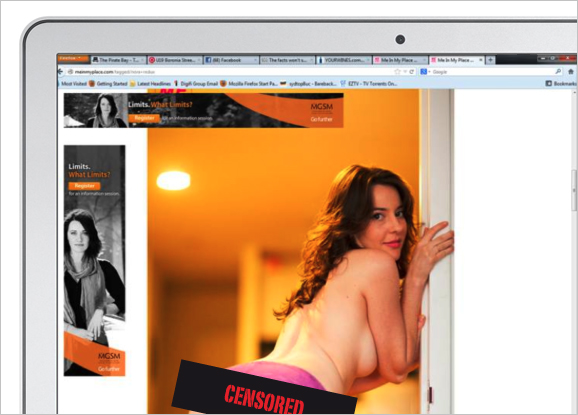
Every medium is out to convince you that their category is the best way to spend your money. They will always have a pie chart to prove it. It’s in their interest to have you spend more of your marketing pie with them. This will increase their commission, irrespective of whether it will increase your return.
For instance, Google Adwords looks a cheap way to buy eyeballs. But if your Adwords campaigner gets into a bidding war for the most popular keywords, you’ll spend more than the same number of leads from less popular search terms. Does the supplier care?
You might think the answer is to use media specialists who charge by time. Like lawyers, they’ll make more the longer their process drags on. More meetings, less decisions, the bigger your bill.
There are now more types of specialists than ever, each fighting for a bigger share of your budget – SEO, PPC, SEM, online content, online ads, email lists, data analysts, mobile, apps, ambient, ambush, experiential, waterproof stickers on urinals…
Which mediums are actually best for your business challenge?
I recommend looking at where to spend a clients’ money from this perspective:
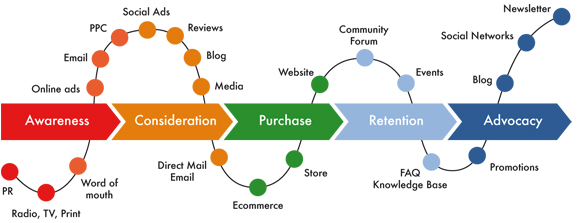
Synergy comes from the right mix, at the right time, with the right creative message. Beware commission driven specialists selling one solution to solve every problem. You’ll get less than you pay for.
Glenn Mabbott
Creative Director & Principal
UNOmarcomms
This article first appeared in AdNews
Read MoreSurvey reveals SMEs fail to measure ROI of online ads
A Yellow Pages survey of 1,800 Australian business owners* has found 69% of small and medium enterprises don’t measure the return on their online ad spend. What’s really surprising in this era of accountability is the finding that only one in 10 base their decisions on where to advertise on the ROI delivered.
What amazes me is the disconnect between business owners increasing desire to do more with less and the missed opportunities these findings reveal.
Advertisers keep telling me they love advertising online because it’s so much cheaper than traditional media. It might be cheaper to buy an adword campaign than a press ad, but are they getting a better return from those clicks?
Do you know which half of your advertising works?
The age-old saying “I know only half my advertising works, if only I knew which half” is just as true of online ad spending as off. The good news is it’s much easier to measure ROI of online marketing than the kinds of activities you used in the past. New technology makes it possible to know what works online and why. Business Intelligence means your spending can truly become an investment with predictable returns.
So if you count yourself amongst the majority of SMEs that don’t have a digital business strategy, maybe you should make it a priority to develop one. After all, there aren’t many things you can do so quickly and effectively that will leave the majority of your competitors behind.
How to measure your marketing ROI
New technologies have also made it much easier to track the performance of your offline advertising and promotion activities. We recently completed another test market campaign for an FMCG customer. In the past it was only major brands that could afford to put in place the kinds of tools needed to measure the ROI of integrated campaigns. Today even challenger brands can track the performance of programs that largely use traditional media because online research, scan data, real time field force reporting and analytics tools are no longer cost prohibitive.
The test and learn approach we have taken with this brand over the last few years has helped lift them above the pack. From being one of half a dozen small players competing for share against a long established multinational, our client is now a clear number 2 in their category. Do you know how much of your marcomms budget is working? There are no excuses because now you can.
* Survey published December 2010


"There are known knowns; there are things we know we know.
We also know there are known unknowns; that is to say, we know there are some things we do not know.
But there are also unknown unknowns – the ones we don’t know we don’t know."
While you may not like his politics, this famous quote from Donald Rumsfeld preceding the US invasion of Iraq perfectly sums up the dilemma faced by business owners today.
People are punch drunk from 5 years of relentless financial destruction of the world’s capital markets. Meanwhile, technology, and especially the digitisation of the world, has seen the pace of change of commerce reach incomprehensible pace. Is it any wonder business managers are floundering?
Challenger brands are making the most of this time of change to gain an advantage over competitors
Many business owners still think they can wait things out until things return to “normal.” What they don't know is the new model for success demands the ability to try new things, quickly and often.
Renee Todres heads a team of digital specialists at Tipping Point that have been helping businesses transform often complex transactions with their customers into simple ones. From BT to Elle Bache, once complicated business processes are being replaced with simple, intuitive interactions that make customers feel in control. Renee makes a wonderful observation –
"to learn you need to listen to yourself less."
Tipping Points approach is to add value by finding new insights. One way to succeed today is to recognise the limitations of your known knowns. Then seek out specialists that can help you discover the unknown unknowns. Get to know the ones that can help improve your position against your competition. And have the confidence to act on those new insights knowing the biggest threat to businesses today is business as usual. The Aussie attitude that she’ll be right now almost certainly guarantees failure.
I'm not suggesting spending all your energies on research. We’ve all seen managers fall into the paralysis by over-analysis trap. Too much data can actually hinder making effective business decisions. According to IBM’s 2012 global survey of 1700 CEOs, asking customers what matters to them is now more useful than financial analysis.
"Of course we need information and insight, but what we need most is the capability to act on it."
Unit head, Government, Hong Kong
In the words of Boston Consulting, today in business “the spoils go to the nimble.” We have found our challenger brand clients are winning by trying new and interesting things, fast and often. In the past you needed big budgets and big balls to try something different. There are now technologies that allow marketers to test new strategies while limiting financial risks.
As Renee and other niche specialists have shown me, it’s surprising how much there is to know that the big brands don’t, simply because they aren't looking.
Read MoreAll those for firing the Marketing Managers? Any against?


When they leave the office for the holidays, many marketing managers won’t realise their role may be restructured out of existence in the New Year. Over the Christmas break, CEOs around the country will be re-appraising who is an expendable cost to the business, versus who is an income generator.
Who will defend so many marketing managers when the case that has been building against them throughout 2012 is so strong?
Here is my snapshot of some of the evidence CEOs may be considering as they weigh up whether to fire their marketing managers:
Evidence A
Many of the tasks that CEOs thought only marketing managers could do can now be Googled. From 99 Designs to freelancer.com any CEO can buy marketing stuff cheap. Whether it’s designing websites or mailers, SEO or adwords, printing or promotions, everything is just a keyword search away. Who cares if you don’t know which half of your advertising works now you can buy it direct at third world prices?
Evidence B
According to this year's Roy Morgan annual professions ranking, marketers have failed again to rise much above used car salesmen. What CEO wants someone with less credibility than a real estate agent on their team? Consider this evidence alongside the growth in Australia of the casual workforce and outsourcing generally.
If you must have a marketing manager, why not buy by the hour, save on fixed and overhead costs.
Evidence C
CEOs have never believed marketers anyway. Fornaise regional survey of CEOs in 2011 found 75% did not value marketing managers opinions at a board level. In July this year the number had increased to 80%.
In November a follow up survey found seven in 10 CEOs hold themselves "somewhat responsible" for marketers’ poor perceived business performance because they have given up on holding their marketing managers accountable. CEOs gave up measuring the performance of their marketing managers. If it isn’t measurable, it won’t be long before the accountants decide marketing managers are an expensive indulgence a lean 21st century business can do without.
Evidence D
Business confidence is at it’s lowest level for four years. More companies went out of business in Australia in the last quarter than any other.
"She’ll be right" is now more wrong than ever. CEOs will have to change the way their business operates to survive. If they don’t know what marketing managers do, it’s an easy place for them to start cutting. As AdNews reported, one recruiter said recently, “companies want to hire revenue generators, and see marketers as passengers not drivers.“
Evidence E
How many CEOs actually know what marketing is? Consider one of the 4 Ps of marketing, price. In the FMCG industry, paying a rebate to Woolworths for a price promotion is still considered a marketing investment, not the sales tool it is.
Evidence F
Consider the other 3 Ps as they apply to businesses today. When do CEOs involve marketing managers in product development, or distribution innovation, or the building of a Business Intelligence driven CRM program? These new silos now fall under Strategy and Innovation Manager or the Supply Chain and Technology Integration Manager or the Chief Information Officer.
Is there a case for marketing managers?
The evidence doesn’t look good if the CEO doesn’t realise marketing managers can add value by thinking across silos. enabling the parts to work in synergy.
The Fornaise study found CEOs “think marketers have continuously failed to unquestionably and consistently prove in the boardroom that their marketing strategies, activities and campaigns generated actual business growth.”
To grow today you have to become a successful challenger brand. To be relevant today marketers have to champion at the board level the power of marketing to create a challenger brand.
If marketers aren’t in the boardroom, either the accountants, the salesmen, even the IT department will contend they need more of the budget to grow the business. Why not take it from the marketing pot, it’s just an artsy fartsy waste of money after all? Isn’t it?
12 days of vintage Christmas ads

Have you heard about the uproar surrounding the latest 'sexist' Christmas ad for ASDA in the UK? Here's your chance in case you missed it.
It seems that history is repeating? Here's a fun look at UNO's 12 days of vintage Christmas ads. They certainly gave us a few laughs!
On the 1st day: What more could a girl ask for?!

On the 2nd day: Should you be tempted to over indulge...

On the 3rd day: What could it be?

On the 4th day: It's the thought that counts!

On the 5th day: The perfect stocking filler!

On the 6th day: Foam filled fun for all the family!

On the 7th day: Taking care of Christmas!

On the 8th day: A shame they didn't make them for dogs too?

On the 9th day: Say it with... spoons?
On the 10th day: We all know that Santa wears red and white because...
On the 11th day: We're sure ASDA would approve!

On the 12th day: Relax in the comfort of your own home
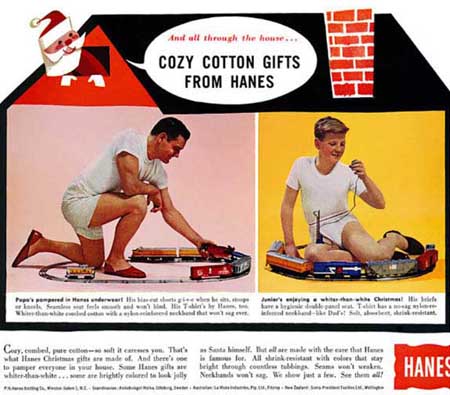
Oh what the heck! One more!
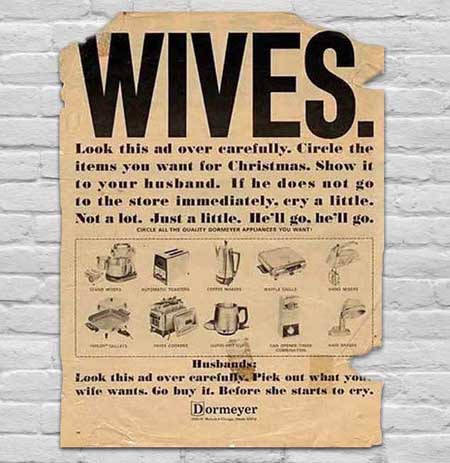
Big businesses' loss can be your gain


In the last few weeks business owners have been warned by the head of one of Australia’s biggest mining corporations that if we don’t change our business models we will die.
So who do business owners turn to for advice? In AdNews the marketing head of one of the big 4 banks reveals agencies don’t get digital. And the CEO of one of the biggest media planners in the country said "anyone in the media industry who claims they know what is happening is lying."
How many consultants does it take to change a light bulb?
Too late, fibre optics and LEDs have changed the market.
Every manager who has grown a business understands the value of seeking advice from specialists, you can’t be an expert at everything. Today we have the added problem that most so-called experts learnt their skills pre-Internet. Most business coaches are dinosaurs, as the world of commerce changes at ever increasing pace, conventional methods won’t save your business if the customer has evolved to a new way of life.
Think biz is tough? It’s even tougher for big businesses
Don’t panic. Unless you are number 1 in your category, you have less to lose by changing the way you play to fit in with the new rules that are being written by the customer. If you are a mid sized business today you have an advantage that in the past was a handicap. Yes, smaller is more nimble. Big businesses with big investments in infrastructure, systems and sunk costs can’t easily re-invent themselves. Think of all those silos of managers in big companies who have to hang in there for another 5 years because their super was decimated. They are a dead weight that slows down change.
Companies falling out of the top 3 in a given year:

Market share leaders that are the profitability leaders:

Forget the past, where’s the future profit coming from?
Most likely from something you are good at now, but not focused on. If you are a mid market player and still in business, you obviously have enough retained knowledge to draw on. Here are some examples of where UNO's clients have found profit opportunities:
- For a manufacturer it was cutting out the wholesalers.
- For a premium winemaker it is leaving Coles and Woollies to the major brands and growing high margin club membership.
- For a financial services B2B supplier it is repackaging bite-sized insights for the consumer market.
Today more than ever, get to know those who know
What you most need now is a trusted advisor who can draw upon a network of today’s specialists. To grow today, you need to re-invent your model, refresh your offer and relaunch by integrating traditional and new ways to market.
Forget incremental improvements. A few percent saved on input costs and a couple more from efficiency gains won’t save you when the competition pockets a whopping 30%+ of margin by removing an entire step in the route to market.
There’s an idea. Better to do it now, or be done over?
For a better career, get a life as a sponge


Many people in marketing seem to think they are judged on what they will do this week, while many managers think it’s about avoiding mistakes by doing very little. Rather than worry about what others may think of your actions/inactions in the short term, a recent conversation with a self-made squillionare reminded me of what it takes to become successful in business life. It’s not about you – soak up other people’s experiences.
Curiosity is the key
This founder of many businesses was as keen to ask questions about my challenges, as I was to learn about his successes.
Creative people continue to take the passive role of waiting for a brief, hoping the application of their current skills to their next project will bring the recognition they deserve. Meanwhile marketing managers act like thought police, determined to minimise all risks on their watch. So the brief ends up something like this: do something safe, measurable (as in lets make sure there are no nasty surprises), something a bit like someone else has already done, and all for less than it cost last time. This lack of desire to explore the unknown is killing creativity in Australia. Yet it’s creativity that builds wealth. Avoiding risk guarantees smaller returns, or none at all. Cutting margins does not create wealth, it just means you’ll spend your way to mediocrity a bit slower.
Today for a business to thrive it has to be a challenger brand. That’s an old company doing things in a different way, or a new one doing new and interesting things. Being a challenger is not about fine-tuning or polishing what you’ve always done. A business that’s in a well-worn smooth groove, just like a career, soon discovers it’s actually in a rut, going the wrong way. New isn’t always better, but better is always new.
If you’re curious to know what it takes to be better at what you do, you’ll do better than your peers. Curiousity, the squillionare says in one of his many books, is what it takes to succeed. It’s more than just appreciating that you don’t know everything. It’s wanting to know what Donald Rumsfeld memorably described as “the unknown unknowns.” Rather than selectively listening to those around you that you feel comfortable with, avoid making bad decisions by seeking out the wisdom beyond your network.
If you’re an art director, it’s time you hung around with some media gurus, marketing managers with entrepreneurs, accountants with digital user experience designers. Innovation after all comes from outside an industry, it’s not found fiddling around with what your category already does. And today if you don’t innovate you and the business will die.
I’ve often explained my life as that of a sponge. From childhood I wanted to know everything about everything. As I’ve met people with passions for things I know nothing about I’ve soaked up drops of wisdom. You’d be surprised what lateral connections from my sodden sponge can draw just the right drop, at the right time, to create an innovative answer. Whatever your role or experience, take every opportunity to learn from others. It helps to be open about your ignorance in front of experts. I’m always asking the silly questions. I usually find if they really are experts, they will gladly share their wisdom. Soak it up.
What's more important to CEOs - financial analysis, or customer insight?


We now work in a world awash with data. But too much data can actually hinder making effective business decisions. According to IBM’s 2012 global survey of 1700 CEOs, asking customers what matters to them is now more useful than financial analysis.
"This is now a continuous feedback kind of world, and we need the organizational nimbleness to respond."
CEO, Financial Markets, USA
"Of course we need information and insight, but what we need most is the capability to act on it."
Unit head, Government, Hong Kong
So how can you get to know your customers better? While there is no substitute for face-to-face, the survey found CEOs of outperforming businesses believe social media is the next best way to gather insights. More importantly, these insights are helping them take action.
In the words of Boston Consulting, today in business "the spoils go to the nimble."
Ten biggest threats to business

A global survey has given us a picture of what exactly the biggest challenges are for business managers today. Across categories and regions the message is the same – there are half a dozen particular issues companies are feeling pressured by, but don’t know how to deal with.
Those clever marketers at Ernst & Young have come up with a catchy way of showing what we’re all facing – they call it the Risk Heat Map.

Businesses of every size are facing the same big problems. Fortunately current research shows how your business can turn this time of rapid change to your advantage.
The real insight for business owners in this picture is that while managers recognise these risks, as we look across the Y axis we realise most don’t know how to deal with them. These challenges are the consequence of a new paradigm. There’s an elephant in the boardroom – it’s right there in the middle, emerging technologies. Yes, it’s the Internet.
Drivers of business change
The Internet has changed everything. For the first time in the history of commerce, we now have true globalisation thanks to the transparency the Internet gives customers. People can now find the truth about any product or service in just a few clicks, in the privacy of their home or using a smart phone on the shop floor.
In the recent past there was still an advantage in being big – a manufacturer could configure a product and control its availability by region, a retailer could price a product depending on the suburb. Today with instant transparency, a customer can pick and choose from what’s on offer anywhere in the world.
Brands can no longer rely on any competitive advantage from tradition, size or resources. Rather, as Boston Consulting says – “in a world of change, the spoils go to the nimble”. The key to success is not just recognising the drivers of change, it’s ACTING on them.
The biggest risk to any business today is inaction. UNO has a proven formula for growing challenger brands. We can help you start today, risk free.
Email gm@unomarcomms.com for an outline of our process.
Read MoreWhat is beauty in commercial art?

“We have a duty to keep ads beautiful” said Craig Davis, co-chairman and chief creative officer with Publicis Mojo Australia and New Zealand in Campaign Asia, yesterday.
I respect Craig, we pitched against each other for The Rocks account decades ago when we were young and radical and creative directors of competing boutique Sydney agencies. I won. The next year I pitched against him again, for Sydney Water. He won.
Personally I don’t think advertising is art. It’s Commercial art, capital C. The latest CEO survey published in the same magazine reports 80% of the region’s CEOs think marketing people “are in La-La Land”.
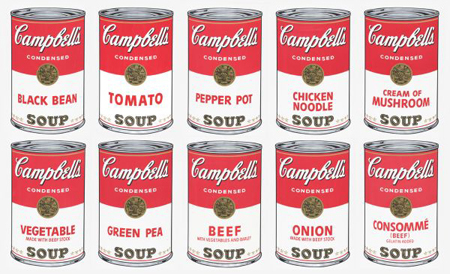
Craig’s musings on beauty in advertising aren’t going to change those perceptions. He is concerned “talent, craft and significance of ideas are being pushed aside by the desire to save time and money.” Craig makes a point worth taking the time to consider – we have all seen examples of the office junior being asked to whip up an ad because they know how to use clip art and can have it done in no time. Or the manager’s nephew is good with computers so he can build the corporate website for less.
All of this is being driven by the changes enabled by the Internet, “the flip side of the new digital meritocracy is that there’s an inordinate amount of noise generated” observes Craig.
He reminds admen “clients pay us to deliver results.” Hear, hear I say.
Then he returns to his point that “at its best, advertising is beautiful, but in the absence of creativity, it is just pollution. In the words of John Keats: Beauty is truth, truth beauty—that is all ye know on earth, and all ye need to know.”
Advertising that works is advertising that delivers a ROI
Business owners are more inclined to see beauty in numbers, like low cost per lead, and high rates of conversion. The fine balance of marketing communications is understanding how to use creativity to commercial advantage.
There is undeniable beauty in identifying a genuine human truth and expressing it to an audience in a way they find appealing. But let’s not talk about beauty for its own sake, lets talk about craft. Both in the craft of storytelling and execution, for business sake.
A century ago Dadaists like Marcel Duchamp challenged the protectors of traditional painting with the question “What is art?”
Before you invest in advertising, social media marketing or any program to grow your business, ask yourself, is this commercial art for the 21st Century? Is the execution well enough crafted to connect with your audience and leave the desired impression? Most importantly, will it give you the best return on investment?
It’s a commercial decision after all, not a beauty contest, don’t you think?
Why CEOs like Facebook yet fear it

The 2012 IBM global CEO study is just out. It once again confirms management is often aware of what needs to change, yet fear acting on their knowledge.
"CEOs need social media, but many fear it" – IBM
The world’s CEOs believe that in the next five years social media will push past websites, call centres and channel partners to become the No. 2 way to engage customers (after face-to-face communications).
However fear of change is preventing most from actually actioning a Facebook strategy. Many will miss capitalising on this inevitable trend to more agile competitors. Some fears are justified, there is no doubt there is risk involved with social media. Risk isn’t just bad ideas like CommBank’s terrorist Olympics viral video.
Advertisers are now liable for users' Facebook comments

Australia's digital industry is up in arms about a ruling from the ad watchdog, which determined a brand's Facebook page is an ad platform with all its material - including user-generated content - liable under the AANA code.
A recent ruling from the Advertising Standards Bureau (ASB) in a complaint against Diageo said it considered Facebook to be a marketing communication tool. The decision changes the landscape of social media advertising with brands liable for content generated by consumers.
In its ruling, the ASB wrote: “The Board considered that the Facebook site of an advertiser is a marketing communication tool over which the advertiser has a reasonable degree of control and could be considered to draw the attention of a segment of the public to a product in a manner calculated to promote or oppose directly or indirectly that product."
Social media advertising regulations and marketing your business
“The Code applies to the content generated by the advertisers as well as material or comments posted by users or friends.”
This is yet another example of how our regulatory frameworks are anachronistic in the era of the Internet. This new world of social media is merely a decade old, yet regulators like ASB are employing codes written in the steam age when ads were only mass distributed by printing press. Publishers had control of what letters to the editor were published with an eye on libel. But the pace of public postings on Facebook makes such a process for an editor of a business Facebook page less that of a publisher, more one of the town crier who invites people to the town square but can’t predict what the crowd will yell about loudest.
Right now the judiciary has similarly lacked an ability to adapt as the public circumvents contempt of court rules and out accused on Facebook, passing collective judgement before a trial. No blurred pictures of the accused’s face like in the press or on TV. Think the Kings Cross king hitter, perhaps fuelled by Diageo products. Lets see a post on a liquor brand’s Facebook about the next alcohol induced murder and ponder the consequences. It's going to happen, irrespective of what the ASB stipulates.
So if CEOs are going to increasingly use Facebook for a dialogue with prospects, we will need to be extremely diligent to keep on the right side of the law, irrespective of how sensible we think regulations are today.
Learn from Darrell Lea's Rocky Road

Darrell Lea's new Perth concept store opened in March. Too late to keep the administrators from the door?
Most business leaders know the 4 Ps from marketing 101. As Darrell Lea’s predicament shows, in today’s marketplace where change is underway at an increasingly blistering pace, keeping those easily understood basics working in your favour is becoming increasingly difficult. Here they are one by one:
Product
Mega trends like multiculturalism, gourmetisation of food products, better for you choices, and social issues like fair trade today shape what we choose to eat.
In the past it was enough to make minor adjustments to products and expect a sales lift simply by placing a NEW IMPROVED flash on the wrapping. For the last couple of decades there’s been little in the way of product innovation at Darrel Lea. As well intentioned as they may have been, small line extensions like fruit flavoured liquorice haven’t been enough to stop the sales decline.
Businesses have to be wary of who they entrust to give them independent counsel. Darrell Lea invested in research that resulted in a new tag line, “85 years of creating sweet magic”. One can argue this simply reinforced a backward looking management mindset.
Today customers are rewarding brave leaps forward in categories. As Max Brenner’s website proclaims, “Chocolate is not just about taste” it’s also about fashion. From Mexican spicy chocolate and hot chocolate shots to chocolate soufflés and Tiramisu, Australians are spending more money on chocolate than ever before as brands can come up with new adventurous ways to tempt them.

Challenger brands aren’t just new companies doing new things, old companies doing things differently are also being rewarded. Australia’s oldest chocolate maker/retailer, 97 year old family business Haigh’s has kept customers coming back and continues to entice new ones with adventurous new takes on chocolates.
Promotion
Cutting back on advertising for a short term cost saving is proven to come at a long term significant loss. Once a significant investor in advertising, Darrell Lea has been absent from mass media marketing for several years. It takes many years to build a brand and nanoseconds to damage one in social media. It pays to treat advertising as a compounding investment that pays an annuity in return.
Price
Too often price is only mentioned in the same sentence as promotion. It is in fact a two way lever. A 4 for $15 offer on Rocklea Road isn’t going to entice a new customer, it simply reduces the margin on a sale to an existing one.

Whereas Lindt, once considered a niche special occasion brand, has grown by offering a variety of chocolate balls across a range of pricepoints and product sizes that still maintain a premium.
Place
The Internet is making everyone reconsider where is the best place to make a sale? Ecommerce may not be right for a product that will melt in the mail, but is owning a shop the best alternative? Why own 63 shops when most chocolate sales are through Coles and Woolworths and convenience stores?
If you are going to have a retail outlet, it needs to have a good reason to justify the high overheads. Darrell Lea’s average over the counter sale is around $11 per customer. You’d need a lot of footfall to justify the rental on the King and George Street Sydney store. On the opposite corners are the eye candy Apple store and Louis Vuitton, where the products cost thousands (and are never discounted).
Challenger brands understand stores are the new 3D interactive ad medium. They are all about theatre and entertainment. Max Brenner has the theatre of their liquid chocolate Willy Wonka-esque stores.
Other retailers realise the store is simply the best way to gather new customers details for database driven online sales. The objective of the shop front is to entice prospects in and the brief to staff is to start a long-term relationship. For instance, banks lose money on physical branches, but haven’t found a better way to gain new customers. Citibank’s new branches in Hong Kong have been designed by the same architects as the Apple Stores. You can’t make a deposit at one of these new gleaming white banks with couches and interactive screens, you can have an espresso made by a barrista who is briefed to cross sell financial products to you.
How to stay competitive
Many market leaders are vulnerable to the threat that comes from failing to re-look at their entire business models. Simply reviewing the 4 Ps from the perspective of traditional wisdom will no longer ensure a business stays competitive. Market leaders that fail to embrace change, not just across product and service but entire systems and relationships, are increasingly less profitable than smaller challenger brands. There are a number of proven tools and techniques to help businesses rapidly adapt and trial new ways, feel free to ask us about some of them.
Boston Consulting has formally identified what savvy marketers know is the driver of business growth today:
In a world of change, the spoils go to the nimble*
*Martin Reeves and Mike Deimler, Boston Consulting Group,
Harvard Business Review July-August 2011

Founded in Adelaide by Alfred E Haigh in 1915, Australia’s oldest family-owned chocolate maker/retailer has a history of embracing change.

In the 1950s grandson John learned from Swiss masters Lindt and Sprungli and introduced European fine chocolate making to Australians. The current fourth generation Haigh family management preside over a business that represents barely 1% of Australia’s chocolate sales. Yet I would venture to say they are very profitable.
By continuing to innovate Haigh's continues to prosper as a challenger brand
Their award-winning Australian Collection was launched in 2003, with six native food centres including quandong, macadamia nut and honey, lemon myrtle and wattle seed. And as Australian’s have become more sophisticated in food tastes, Haigh’s have kept up with such adventurous chocolates as a South Australian truffle duet made with premium wines from the State’s wine regions.
Haigh’s environmental policies and sponsorships are just one indicator of how in touch this old business is with today’s consumer.
Last August at the Family Business Australia Conference, Joint Managing Director Alister Haigh told me they were ready for the next big change - online sales. The only sticking point is developing a delivery method that can guarantee the integrity of their heat sensitive product.
Following the biggest fine in UK finance history, it’s timely to look again at Barclays’ Big Ad

Barclays agreed to pay a record $442 million fine for rigging the London interbank offered rate last month. The scandal has cost the jobs of Barclays CEO Robert Diamond (below), Chairman Marcus Agius, and Chief Operating Officer Jerry Del Missier.
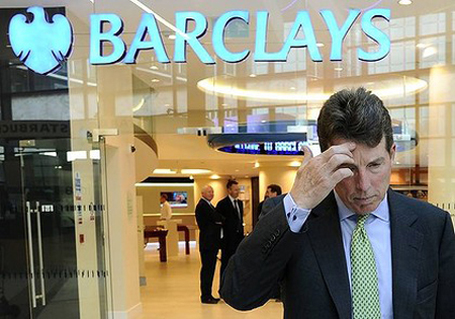
It pays to consider the future consequences of a single-minded marketing tagline. For Barclays, “We’re Big” just doesn’t cut it anymore.
If you're a marketer, Read This Or Die...

A friend sent me a YouTube link via Facebook – a comedy sketch by Bill Hicks, where the comedian asks anyone in the audience that’s in advertising or marketing to “kill yourself".
I was reminded of my profession’s tenuous grip on social acceptance when this week leading researchers Roy Morgan released their latest annual survey of how Australians rate the professions: ad people are still near the bottom, just above car salesman.
There is still hope for Admen and marketers – it’s about having conversations at the board level that explain in understandable terms how we can add value. This week McKinsey Quarterly published a checklist of 5 things that will help business managers get the best ROI from their marketing.
So for those who rate the wisdom of McKinsey's consultants, here in my words are the 5 tips that will make any CEO take you seriously.
1. What exactly influences our consumers today?
Mass media marketing to the masses is oh so yesterday. Thanks to the Internet, shoppers now consider options at more times in more ways, from reading online reviews to comparing prices when in-store using their mobiles. Once someone has bought something, they potentially become a reviewer themselves.
So how do you get into the new consumer's head? You can use anything from traditional research to online polls or social media tracking to get a better understanding of what consumers are now thinking about a category. The key is to be open minded about what you learn and have a management team willing to let go of accepted wisdoms.
2. How well informed (really) is our marketing judgment?
It was only a decade ago when traditional advertising was all that mattered. Marketers who new their stuff could make decisions safe in the knowledge what always worked in the past probably would tomorrow. And planned accordingly. Today you have to be able to recognise signals of change, and act on them. This means managers have to move out of their comfort zones and hypothesise, test new ways, then measure, analyse and adapt. Again and again. In McKinsey’s words there has always been a a need to define a “clear relationship between marketing spending and business results”. Today it has shifted from “should we be spending on marketing at all?” to “what’s the optimum marketing spending needed to hit our targets?”
3. How are we managing financial risk in our marketing plans?
Successful marketing communication takes hitting the right audience with the right message at the right time. The difference today is the targets are increasingly individuals and they are moving faster than ever. Traditional mass media allows advertisers to minimise risk by using metrics based on years of surveys that measure frequency and impact of a particular medium. Not so now. With today’s new media “influence can shift rapidly, and there is little accumulated experience about which messages work, when marketers should apply them, how they can be scaled, or even whom they influence”.
Measurement and risk reduction today comes from a closer relationship between sales and marketing and the channel. One of our clients has found scan data has new meaning now it can be overlaid with pre and post campaign brand tracking and the incredible analytics available using Shopperpedia.
4. How are we coping with added complexity in the marketing
organisation?
If you think it’s hard to keep up now, it’s only going to get harder faster. McKinsey's unsurprisingly suggest “you’ll require a number of specialists. You can’t get the skills and knowledge you need in just one person, and you’re not likely to get everything you need internally”.
5. What metrics should we track given our (imperfect) options?
At this point McKinsey goes into a whole grab bag of consultant speak. At UNO we think it best to get back to business basics – success should be measured by profit, not volume of sales or market rank. A business is successful when it can compete on more things than just price. And it knows it’s a real challenger brand when staff and partners are aligned and customers are referrers.
Now if you’re in advertising or marketing and you can’t get your head around the idea you have to change to survive, take a couple of minutes to laugh out loud as Bill Hicks encourages you to kill yourself
Where the smart budgets are being spent...Social Media
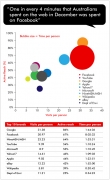
Have you noticed over the last decade that just about anything that isn’t nailed down has been digitised. Today we can access nearly everything from anywhere on anything – from getting the news on a tablet, trading shares on a mobile or accessing software services from the cloud. Plumbers are relatively safe, but most other businesses have to change.
The difficulty for business managers though is not just deciding how to make the change to digital, but how to make money out of it...
Pew Research Centre in the United States found that digitisation is burning money
Newspapers lost $10 in print ad revenue last year for every $1 they gained online. Just five companies, none of which existed a couple of decades ago are now taking 68% of online ad revenue: Google, Microsoft, Yahoo, AOL and Facebook.
Marketers know that they need to integrate traditional mediums with digital. Few businesses actually do – and some still think online is primarily for brands with young customers.
Businesses may be surprised to discover that the place where Australians spend the most time online, is also the most popular with women 25-45 years old.

The papers continue to spend money on journalists and creating the content, while these new companies continue to grow their revenue off the papers’ labours. Now because of their growing databases, fuelled by an understanding of people’s behaviour and preferences gathered from social media use, the digital intermediaries can now target ads more precisely than the old publishers.
The things we can now do on Facebook are incredible. In the past only advertisers who could afford to buy expensive data and research could precisely target their consumers. Now any advertiser can pretty well plan as effectively as the global giants by tapping into the growing wealth of intelligence of the social media technologists.
The Pew report says: “Two trends in the last year overlap and reinforce the sense that the gap between the news and technology industries is widening. First, the explosion of new mobile platforms and social media channels represents another layer of technology with which news organisations must keep pace. Second, in the last year a small number of technology giants began rapidly moving to consolidate their power by becoming makers of 'everything' in our digital lives. Google, Amazon, Facebook, Apple and a few others are manoeuvring to make the hardware people use, the operating systems that run those devices, the browsers on which people navigate, the e-mail services on which they communicate, the social networks on which they share and the web platforms on which they shop and play. And all of this will provide these companies with detailed personal data about each consumer.”
Business journalist Leon Gettler points out “Newspaper groups like Fairfax are the canaries in the coal mine for other industries facing similar challenges, from book shops and publishing to health care, industries where barriers to entry are low and where information is the main product. The trend to digitisation will accelerate with 'Generation C', people born from 1990 on who expect to be constantly connected through every possible device now entering the workforce, and with costs of computing and technology equipment dropping.”
“In every organisation, from media to retailers like David Jones, Myer and Harvey Norman, the biggest challenge always comes down to the tension between those who advocate a more aggressive approach and those aligned with legacy traditions, those who want to go fast and those who want to slow down.”
Adaptability: the new competitive advantage
As the pace of change accelerates, adaptability becomes the new competitive advantage. Long established leaders like Kodak, Borders and Fletcher Jones are a lesson in what management can expect if they don’t change their business model to integrate digitised marketing with their traditional methods.
Sources: Leon Gettler, Business Spectator, 28/3/12
Pew Research Centre, How Newspapers Are Faring Trying to Build Digital Revenue, 5/3/12
Why are marketers using Smartphones today?

The answer is in the numbers, and is a pointer to the next big thing.
Google researched 300,000 people around the world to find out their Smartphone use. Now as Australian marketers we can compare and contrast markets.
Number 2 for Smartphones in the world
Australia is now ahead of the US, UK, and Japan.
Average Smartphone under 12 months
Most of Australia’s Smartphones were purchased in the last 12months. We’ve gone from the back of the pack to the second highest penetration of this technology in the last year. Every month 1-2% of the entire population of Australia buys a Smartphone.
81% do it at home
More Australians used their Smartphones at home during the past 7 days than out – just 66% use them on the go.
50% like to watch
Almost 1 in 2 use their Smartphone while watching TV, while 1 in 3 use Smartphones and another Internet-enabled device at the same time. Talk about adult ADHD media consumption.
Smartphones are good for business
49% use their Smartphone to research and then call businesses – and 45% visit a business they’ve found using their Smartphone.
Aussies are obsessed with real estate
The stats confirm what we’ve all known from dinner party conversations – 1 in 5 Australians surveyed had looked for an apartment or house with their Smartphone – that’s 33% higher than the US or UK.
40% search daily
2 in 5 of Australian Smartphone owners use mobile search daily, that’s more than the UK or Germany and almost as high as the number who use desktop search daily.
The number of queries about retailers made via mobile devices has jumped 220 per cent year on year, and is now about 25 per cent of all queries.*
App, app and away
Australian survey respondents had 25 apps on average per Smartphone, Vs 23 in the US & UK. We’re not just talking free apps; Australians averaged 8 paid apps per phone.
TV or not TV?…
1 in 5 Aussie Smartphone owners would rather give up their TV than their Smartphone.
Better than sex?
1 in 3 say so according to a Telenav survey, that’s how many would choose their Smartphone rather than sex.

Now you’re up to speed with the omnipresence of mobile you’ll need to start thinking about how you can extend your online activity beyond a website that is viewed on a PC.
But wait, there’s more. Nothing stands still nowadays; to keep up you also need to be thinking of how to stay ahead of the competition.
So what’s next?
In just a year Australians have learnt to surf the web, send emails and watch movies on a Smartphone. Now consumers are moving to tablets because they are more convenient than laptops and obviously have a bigger screen than Smartphones.
1.2 million this year
In 2011 tablets will outsell Smartphones in Australia. 64 million tablets will be sold worldwide by the end of this year. #
73% of them will be iPads
Apple will sell 47 million iPads this year.#
We believe video to mobile devices is a game changing opportunity for challenger brands. Until now many marketers have been held back by the high cost of entry of mass media advertising. The amount of media consumption online has risen from 25 per cent in 2007 to about 42 per cent now. A new buzzword for marketers in the US is ''SoLoMo'' – as in social media, local networks and mobile. Savvy marketers are recognising the need to develop strategies that make the most of these new, powerful mediums. *
We believe you can now punch above your weight more effectively than ever by integrating video and content to create a genuine one-to-one dialogue on customers’ mobile devices. You’ll be surprised what is now possible…
50% conversion rate
50 per cent of people who inquired about a hotel via a mobile device went on to make a booking within a couple of days, compared with 20 per cent for those online via a computer. *
Give me a call on my Smartphone, 0412 982 538, if you’d like to know more.
*Ross McDonald, Google, 9/12/11
#Gartner, 8/12/11
"Greenwashing" Why a great idea that isn't true is a bad idea


What a shame this great ad for Steggles wasn’t for a producer of real free-range eggs. It was pulled because it’s a lie, even though beautifully told. Every person in every agency should be stegglers for detail.
The public deserves better than marketers passing off intensively “farmed” produce as free range when there isn’t room for the animal to scratch itself. “Greenwashing” takes many forms, like adding the claim Hormone Free to chicken packs when it’s been illegal to add hormones to any farmed chicken in this country since 1968.
At the moment here at UNO we are working on a campaign for an Australian innovation, the first plastic to biodegrade in modern landfill, which is where a billion disposable coffee cups end up each year across our country. We have told our client he can succeed as a challenger brand by telling the truth. There will be no green washing, just the facts about what this product can and can’t do. And we’ll do that the way all ad people should, with creative wit and human insight.
J Walter Thompson’s words of over 100 years ago are as right today as ever – “The truth, well told” is why we get up in the morning.
See the vodcast about what makes biorene biodegradable – the Earth eats it up!







Scan the QR code for our contact details.
Download the Neoreader app.
© COPYRIGHT 2013 UNO marcomms Privacy